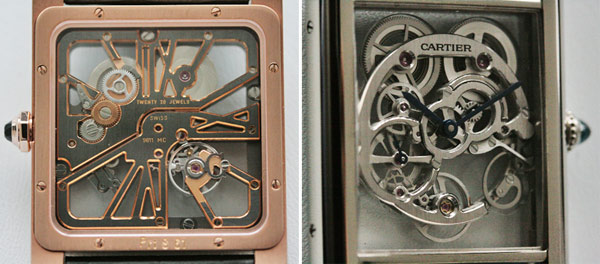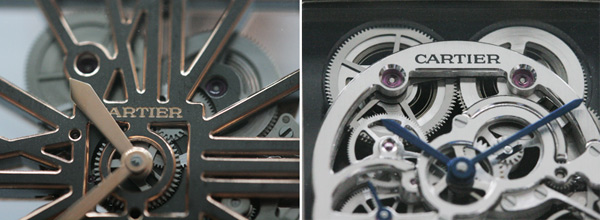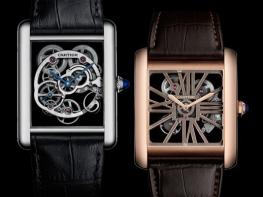In less than six years, having started from scratch, Cartier has built itself a portfolio of Manufacture movements that represents a genuine rarity. There are now more than 20 movements with the MC prefix. Among them are a number of skeleton models – a style the brand has interpreted in various ways. Two of them in particular are true look-alikes. On my left, Calibre 9619 MC powering the Tank MC Skeleton watch; and on my right, the 9616 MC driving the Tank LC Skeleton Sapphire model belonging to the Tank Louis Cartier line. The kinship between these two calibres is strong, since they are derived from the same base movement. Both feature a twin barrel ensuring a three-day power reserve. Their shared features are a perfect illustration of a certain pragmatism shown by Cartier; while their differences stem from their intelligent construction.

Modifying a calibre is no easy task. Changing its appearance, its oscillating weight or the cut of certain bridges is not a major technical issue. But as soon as one begins moving around some of its components, things get a lot more complicated. This means that far from being a matter of an economy of means, the transition from Calibre 9619 to 9616 is in fact a redevelopment. In the former, the movement components are held between two skeletonised plates that reproduce the hours in Roman numerals – one of the hallmarks of the Cartier style. In the latter, the plate is an almost closed ring, a long capital C – another signature of the brand. It is dotted with holes drilled to house the wheels and pinions, jewels and other parts. Achieving this arrangement involved redistributing most of these components.

The first difference lies in the barrels. In the 9619, they are placed at around 12 o’clock on the movement, although not aligned with each other. In the 9616, they are no longer offset but instead symmetrically positioned in relation to the central axis of the watch. The second variation concerns the winding mechanism. In the former movement, it is classic and concealed beneath the 3 o’clock position; in the latter, it is offset to 4 o’clock, considerably lighter and held in place by an elegant semi-circular jumper-spring. As a round shape on another round shape, it lends a little dynamic touch which, far from being a mere detail, provides eloquent proof of the care devoted to the appearance of this calibre. The third divergence is the offsetting of the escapement by a few degrees, meaning that instead of being carried by a large quadrilateral bridge on the 9619, it is placed on the C-shaped plate of the 9616, thereby perfecting the metaphor of the circle inside a circle.

The fourth difference is that Calibre 9619 is fixed inside the Tank MC case middle, whereas the Tank MC is two millimetres slimmer (at 7.45 mm) and diaphanous, since the movement is encircled by transparent sapphire and appears to be floating in mid-air. Since sapphire cannot be screwed in and is both brittle and fragile, it calls for a far more complex fastening technique than a classic skeleton movement. In this model, it is held between four water-resistance gaskets that surround it and ensure flexibility as well as optimal shock-absorbing capacity.

The fifth and final difference is a substantial one, in that the style of these two watches is entirely incomparable. Having started out with the expressive, powerful and distinctive calibre of the Tank MC, Cartier has succeeded in creating a delicate, translucent and almost fragile watch. The skeleton concept is supple by definition. By playing with various hollowed-out or solid areas, a watch movement constructor can create quite different designs, shapes and appearances. But in these particular instances, Cartier has taken these possibilities to a whole new level: that of transfiguration.







